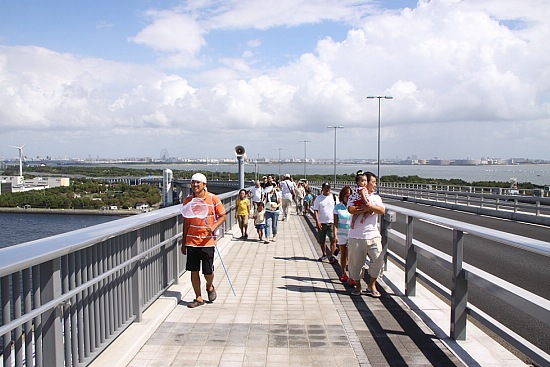Exploring Tokyo: Gate Bridge
by Sean, staff writer of japan-guide.com
| previous post |
| next post |
2012/09/17 - Exploring Tokyo: Gate Bridge

Today I explored grounds in Tokyo that didn't exist a century ago. I walked through Wakasu, Shin-kiba and Yumenoshima, which are among the several small islands around the Tokyo Bay area that were formed by land reclamation in recent history.
My day started at the Gate Bridge, which was newly opened to traffic in February this year. The bridge is part of the Tokyo Port Seaside Road that connects Wakasu to Jonanjima, allowing traffic the option of bypassing central Tokyo to get between its east and south. The bridge is also nicknamed "Dinosaur Bridge", because it pretty much resembles two T-Rexes facing each other.
There was a healthy crowd here today. I saw many excited faces, which reflected my feelings about crossing the Gate Bridge for the first time.








Only the Wakasu end of the bridge is open to pedestrians, so after crossing it, I returned to where I had started and walked towards Wakasu Park. This is where people enjoy camping. I read a sign saying that you could camp here for a maximum of three nights in a row for three hundred yen per day, so for tourists on a tight budget, here's an option.
There was a jovial atmosphere: the laughter of the people having a good time, the cyclists along the cycling tracks, the smell of burning charcoal from the barbecue pits, and a soccer ball that rolled to my feet.





Upon further exploration, I found out that the west of Wakasu is mainly industrial and has many lumber yards, just like Shin-kiba, which lies just north of the canal separating the two pieces of land. The area's geographical location - being close to central Tokyo and situated along the sea - makes it suitable as a lumber distribution center.
Shin-kiba literally means "new place to store wood", a fitting name for where Tokyo's main lumber yards are concentrated. The original "place to store wood", Kiba, is these days shielded from the sea with the emergence of reclaimed land, and thus no longer functions as a lumber yard.




I walked around Shin-kiba and saw many other interesting things. One that caught my eye was the number of trucks that parked by the roads, bearing number plates from locations all over Japan, even as far as Kyushu. They were probably waiting for their batch of wood to be loaded onto their trucks, before heading home. The trucks all had drawn curtains hiding the front seats: I'd imagine behind those curtains were drivers taking naps after long journeys.
Besides wood-related industries, there were several recycling and concrete factories as well.




As I walked on towards Yumenoshima, I passed by this club which, judging by the number of people queuing at its doors, should have had a very successful event:

When I first heard of Yumenoshima, images of paradise appeared in my head as the name means "Dream Island". Then I gained knowledge that it was a waste landfill in the past, only converted into an island in the 1960s. And so you could probably understand why it felt like shattered dreams when I first heard it being associated with garbage. But no, these days Yumenoshima is closer to being a paradise than a dump: here there are parks, sport facilities and waterfront promenades.
Energy generated from incineration plants at the island are used to supply heat to the green house of the Yumenoshima Tropical Plant Garden during colder months. The garden features a large greenhouse showcasing various tropical plants.
I also visited the exhibition house of the Daigo Fukuryu-maru, a wooden fishing boat which was damaged by a hydrogen bomb test which took place on the Bikini Atoll in 1954. The exhibition house is dedicated to informing the public of the dangers of atomic hydrogen bombs, with the hope that no such tests would ever be carried out again.






After an enjoyable day's walk, I finished at the Yumenoshima Marina, where there were many yachts parked. People come here to take their yacht steering lessons and examinations. Just when a famished stomach growled to remind that it was time for late lunch, a waterfront restaurant appeared right before my eyes; it was time to let my stomach do the walking.


| previous post |
| next post |